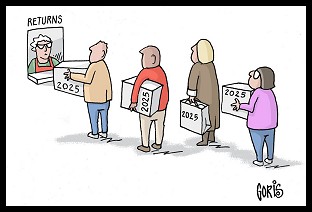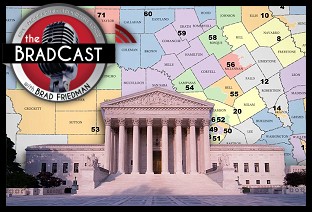 "They wanted substantive change and were willing to burn it all down to get it." These words, from a neighbor in the rural north country of New York, describe the thinking of some who voted for Donald Trump. Some of these same voters had supported Bernie Sanders in the 2016 primary (more on that below).
"They wanted substantive change and were willing to burn it all down to get it." These words, from a neighbor in the rural north country of New York, describe the thinking of some who voted for Donald Trump. Some of these same voters had supported Bernie Sanders in the 2016 primary (more on that below).
Four years later, some have suggested we should shy away from Sanders, on the grounds that he cannot beat Trump. Election statistics, however, as well as current polling, reveal that he would, in fact, be a viable candidate. This is not the same thing as saying he will win. But, based on actual existing hard numbers that we can examine, he is certainly not "unelectable" as some critics have charged.
Bernie Sanders, having run for President in 2016, is the only Democratic candidate with a recent track record in presidential politics that can be used as a yardstick, unlike several of the other current front-runners such as Elizabeth Warren or Pete Buttigieg. So, let's look at what the raw numbers tell us about Sanders' electability against Trump, bearing in mind that this all could change when full-throated attacks are unleashed against him, as they inevitably will be against whoever wins the Democratic nomination...
Firstly, Dave Leip's US Election Atlas website recorded what we need to know about the 2016 electorate. To begin with, if you add up the vote totals in the 2016 primaries and caucuses, Sanders received more votes, overall, than Trump during that cycle.
Sanders: 13,243,376 (primaries) + 460,030 (caucuses) = 13,703,406 (total votes)
Trump: 13,310,471 (primaries) + 252,773 (caucuses) = 13,563,244 (total votes)
To be sure, in most of these primaries Trump was running against a larger field (although by Super Tuesday at the beginning of March, the Republican field was down to five candidates); and four states (Kentucky, Nebraska, Idaho and Washington) held a primary in one party and a caucus in the other. So the comparison is inexact, but it is informative. The total votes, by party, in primaries and caucuses, were as follows:
Democratic: 30,895,719 + 740,055 = 31,635,774 (Sanders received 43.32%)
Republican: 29,646,417 + 934,141 = 30,580,558 (Trump received 44.35%)
It is fair to say that Sanders and Trump were the first choices of an almost equal number of their respective party primary voters during the 2016 cycle.
Secondly, look at the states that Sanders won: much of the "Blue Wall" (Michigan, Wisconsin, Minnesota), most of the Great Plains (Oklahoma, Kansas, Nebraska, North Dakota), most of the Interior West (Colorado, Utah, Idaho, Montana, Wyoming), and the "red states" of West Virginia, Indiana, and Alaska (plus four New England states and three Pacific states).
No, Sanders is no more likely to win reliably red states just because he defeated Hillary Clinton in primaries there than he would be to lose reliably blue states in a general election just because he lost primaries there. But his strength in the "Blue Wall" is crucial, because that is where the 2020 election is likely to be decided. And his relative strength over Clinton in red states is important, because it might help get some Democrats elected to Congress and other state or local offices.
Thirdly, look at the counties that Sanders won in 2016. (Click on the desired state on Dave Leip's maps, and compare the Democratic primaries to the general election). Begin with the battleground states that Clinton lost to Trump.
- PA: Sanders carried thirty rural counties. Clinton carried one of these against Trump.
- OH: Sanders carried sixteen rural counties. Clinton carried one of these against Trump.
- MI: Sanders won the state, carrying 73 of 83 counties. Clinton carried five of these against Trump.
- WI: Sanders won the state, carrying 71 of 72 counties (all except Milwaukee). Clinton carried eleven of these against Trump.
- IA: Sanders lost the state by a mere 355 votes, carrying 37 of 99 counties (four were draws). Clinton carried five of these against Trump.
- NC: Sanders carried eighteen counties, fifteen of them in the Appalachian Mountains. Clinton carried three of these against Trump.
- FL: Sanders carried nine rural counties, all in north Florida. Clinton carried none of these against Trump.
I am not suggesting that Sanders would carry all these rural counties against Trump. I am saying that the available evidence suggests he would almost certainly do better in these counties than Clinton did. In the general election, it is the "Blue Wall" (PA, OH, MI, WI, MN and IA) where this matters. It would be more difficult for Trump to run up the huge margins in rural counties that he would need to overcome the Democratic strength in urban areas.
Fourthly, I am not convinced that the vote counts in the Democratic primaries were everywhere true and correct. I examined the official results and the exit polls in great detail in 2016, and called for inspection of the actual ballots [PDF], because of large disparities between exit polls and official results in black communities, especially in six southern states on Super Tuesday, and between absentee ballots and Election Day results in three Midwestern states in later primaries.
Fifthly, the Real Clear Politics (RCP) polling averages for nationwide head-to-head general election matchups as of this posting show that both Joe Biden and Bernie Sanders are electable. As of mid-January, Biden was leading Trump by 4 points (48.2% to 44.2%), and Sanders was leading Trump by 2.6 points (48% to 45%).
And these polling averages include an obvious outlier --- a USA Today poll that shows Biden losing to Trump by 3 points (41% to 44%), and Sanders losing to Trump by 5 points (39% to 44%). The reason why Biden and Sanders performed so poorly in that USA Today poll is because it included "an unnamed third party candidate" who "received between 11% and 15% in the head-to-head contests." This suggests that Trump's best scenario would be if a third party candidate siphons enough votes from the Democratic candidate to throw the election.
The RCP polling averages for battleground states show that Biden would be more difficult to beat than Sanders. As of mid-January, Biden had a lead of 6.5% points, or more in enough states to win the electoral college. This, of course, is the most important metric. The same polls show that Sanders is also electable, though less so, with a lead of 2.5% or more in enough states to win.
Lastly, allow me to emphasize why candidates "tack to the center" in general elections. Luring one voter away from your major party rival equals a net gain of two votes (they lose that one vote, and you pick it up), and is therefore twice as valuable as luring one voter who would otherwise vote for a third party candidate or not vote at all. Turning out your base is very important, but so is chipping away at your opponent's strength.
Sanders has demonstrated that he does not have to "tack to the center" in order to do this. He won those rural counties while running to the left of Hillary Clinton. How many were voting against Clinton more than they were voting for Sanders we do not know. But the fact remains that the counties Sanders carried against Clinton are, by and large, the same ones the Republicans are counting on to get Trump reelected.
In fact, an actual poll of 64,600 respondents, all of whom voted in both the primary and the general election, found that 12% of the very same people who voted for Sanders in the primary voted for Trump in the general election. The data show that Clinton's inability to win over these Sanders voters may have been decisive in Pennsylvania, Michigan and Wisconsin.
This would amount to more than 1.6 million voters nationwide, or 1.2% of the popular vote, which Hillary Clinton won by 2.1%. Trump might not be able to hold these voters if Sanders wins the Democratic nomination. This could alter the margin between the candidates by 2.4% and provide a 4.5% margin of victory for Sanders, which is very much in line with the head-to-head polling average reported by RCP.
The point of this article is not to predict the future, which none of us can do. Rather, it is to show, based upon hard data, that --- despite rhetoric from various talking heads and advocates --- Democrats do have a real choice in the primaries. Those whose only concern is defeating Donald Trump may rally around Joe Biden, and those who are seeking substantive change may rally around Bernie Sanders.
Current polling suggests that other Democratic candidates would be electable as well. Democrats should not be afraid of a spirited primary contest between two or more viable candidates. What they need to do, as recent polling data also reveal, is unite behind the ultimate winner.
Richard Hayes Phillips is a published historian and genealogist whose books, Without Indentures, Birth and Shipping Records, and The Search for Survivors, are available in paperback from Genealogical Publishing Company, and in hardbound archival editions are available directly from the author for the same price as the paperbacks. He is also an election fraud investigator whose unprecedented forensic probe of the 2004 Presidential election in Ohio is documented in Witness to a Crime: A Citizens' Audit of an American Election. Signed hardcover copies are also directly available from the author.


 'Green News Report' 1/6/26
'Green News Report' 1/6/26
 Trump's War on Venezuela is About Ego, Power, Creation of 'Alien Enemies': 'BradCast' 1/5/26
Trump's War on Venezuela is About Ego, Power, Creation of 'Alien Enemies': 'BradCast' 1/5/26 Sunday 'Peace President' Toons
Sunday 'Peace President' Toons Sunday 'Many Happy Returns' Toons
Sunday 'Many Happy Returns' Toons Have a Holly Jolly Somehow
Have a Holly Jolly Somehow 'Tis the Sunday Before Christmas Toons
'Tis the Sunday Before Christmas Toons Old Man Shouts at People from White House for 20 Minutes, and Other Year-End Matters: 'BradCast' 12/18/25
Old Man Shouts at People from White House for 20 Minutes, and Other Year-End Matters: 'BradCast' 12/18/25 'Green News Report' 12/18/25
'Green News Report' 12/18/25 SCOTUS Ruling a How-To for Unlawful Gerrymandering on 'Eve' of Critical Election Year: BradCast' 12/17/25
SCOTUS Ruling a How-To for Unlawful Gerrymandering on 'Eve' of Critical Election Year: BradCast' 12/17/25 Bricks in the Wall: 'BradCast' 12/16/25
Bricks in the Wall: 'BradCast' 12/16/25 'Green News Report' 12/16/25
'Green News Report' 12/16/25 'This One Goes to 11': Weekend of Violence, Murder of Rob Reiner: 'BradCast' 12/15
'This One Goes to 11': Weekend of Violence, Murder of Rob Reiner: 'BradCast' 12/15 Sunday 'WTF?' Toons
Sunday 'WTF?' Toons Trump Now Losing One Battle After Another: 'BradCast' 12/11/25
Trump Now Losing One Battle After Another: 'BradCast' 12/11/25 'Green News Report' 12/11/25
'Green News Report' 12/11/25 Dems Continue Stunning 2025 Election Streak: 'BradCast' 12/10/25
Dems Continue Stunning 2025 Election Streak: 'BradCast' 12/10/25 Petrostates and Propa-gandists Undermining Climate Science: 'BradCast' 12/9/25
Petrostates and Propa-gandists Undermining Climate Science: 'BradCast' 12/9/25 The High Cost of Trump's Terrible Policy Making: 'BradCast' 12/8/25
The High Cost of Trump's Terrible Policy Making: 'BradCast' 12/8/25 Dems Fight to Avoid GOP's Year-End Health Care Cliff: 'BradCast' 12/4/25
Dems Fight to Avoid GOP's Year-End Health Care Cliff: 'BradCast' 12/4/25 A 'Flashing Red Warning Sign' for GOP: 'BradCast' 12/3/25
A 'Flashing Red Warning Sign' for GOP: 'BradCast' 12/3/25 Hegseth, War Crimes and DoD's 'Politicization Death Spiral': 'BradCast' 12/2/25
Hegseth, War Crimes and DoD's 'Politicization Death Spiral': 'BradCast' 12/2/25 Follow the
Follow the  With Thanks, No Kings and Good Cheer
With Thanks, No Kings and Good Cheer
 VA GOP VOTER REG FRAUDSTER OFF HOOK
VA GOP VOTER REG FRAUDSTER OFF HOOK Criminal GOP Voter Registration Fraud Probe Expanding in VA
Criminal GOP Voter Registration Fraud Probe Expanding in VA DOJ PROBE SOUGHT AFTER VA ARREST
DOJ PROBE SOUGHT AFTER VA ARREST Arrest in VA: GOP Voter Reg Scandal Widens
Arrest in VA: GOP Voter Reg Scandal Widens ALL TOGETHER: ROVE, SPROUL, KOCHS, RNC
ALL TOGETHER: ROVE, SPROUL, KOCHS, RNC LATimes: RNC's 'Fired' Sproul Working for Repubs in 'as Many as 30 States'
LATimes: RNC's 'Fired' Sproul Working for Repubs in 'as Many as 30 States' 'Fired' Sproul Group 'Cloned', Still Working for Republicans in At Least 10 States
'Fired' Sproul Group 'Cloned', Still Working for Republicans in At Least 10 States FINALLY: FOX ON GOP REG FRAUD SCANDAL
FINALLY: FOX ON GOP REG FRAUD SCANDAL COLORADO FOLLOWS FLORIDA WITH GOP CRIMINAL INVESTIGATION
COLORADO FOLLOWS FLORIDA WITH GOP CRIMINAL INVESTIGATION CRIMINAL PROBE LAUNCHED INTO GOP VOTER REGISTRATION FRAUD SCANDAL IN FL
CRIMINAL PROBE LAUNCHED INTO GOP VOTER REGISTRATION FRAUD SCANDAL IN FL Brad Breaks PA Photo ID & GOP Registration Fraud Scandal News on Hartmann TV
Brad Breaks PA Photo ID & GOP Registration Fraud Scandal News on Hartmann TV  CAUGHT ON TAPE: COORDINATED NATIONWIDE GOP VOTER REG SCAM
CAUGHT ON TAPE: COORDINATED NATIONWIDE GOP VOTER REG SCAM CRIMINAL ELECTION FRAUD COMPLAINT FILED AGAINST GOP 'FRAUD' FIRM
CRIMINAL ELECTION FRAUD COMPLAINT FILED AGAINST GOP 'FRAUD' FIRM RICK SCOTT GETS ROLLED IN GOP REGISTRATION FRAUD SCANDAL
RICK SCOTT GETS ROLLED IN GOP REGISTRATION FRAUD SCANDAL VIDEO: Brad Breaks GOP Reg Fraud Scandal on Hartmann TV
VIDEO: Brad Breaks GOP Reg Fraud Scandal on Hartmann TV RNC FIRES NATIONAL VOTER REGISTRATION FIRM FOR FRAUD
RNC FIRES NATIONAL VOTER REGISTRATION FIRM FOR FRAUD EXCLUSIVE: Intvw w/ FL Official Who First Discovered GOP Reg Fraud
EXCLUSIVE: Intvw w/ FL Official Who First Discovered GOP Reg Fraud GOP REGISTRATION FRAUD FOUND IN FL
GOP REGISTRATION FRAUD FOUND IN FL

































